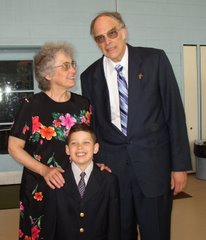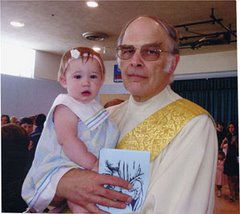John 16:12-15
During the 11th century
some bishops proposed to Pope Alexander that a special feast be set
aside to honor the Blessed Trinity. Pope Alexander replied that he
was against this idea because it would mean that priests and bishops
would try to explain the Trinity, and that would always lead to
heresy. About one hundred years later Pope John the twenty-second
did proclaim the feast we celebrate today. Pope Alexander's worries
came true. If you have a little time and a computer, go to You Tube
and enter “Saint Patrick's bad analogies”. It's very clever;
Saint Patrick meets two Irish peasants and tries to explain the
Trinity; with each attempt, they point out that he's just made
another heretical statement. It's a good introduction to the
problems we face.
There is the heresy of partialism like
comparing the Trinity to a shamrock. There's the heresy of modalism,
if you compare the Trinity to how a woman can be a wife, a mother,
and a daughter all at the same time. There's the heresy of
Tritheism, if you say that the Father creates, the Son redeems, and
the Holy Spirit sanctifies. And don't forget Adoptionism, when you
see the Father as in some way superior to the Son or the Spirit.
And one of the greatest theologians,
Saint Gregory Nanzanzien, explained the Trinity in this way: “No
sooner do I conceive of the One than I am illumined by the splendour
of the Three; no sooner do I distinguish Three than I am carried back
into the One. When I think of any of the Three, I think of him as the
whole, and my eyes are filled, and the greater part of what I am
thinking escapes me. I cannot grasp the greatness of that One so as
to attribute a greater greatness to the rest. When I contemplate the
Three together, I see but one torch, and cannot divide or measure out
the undivided light."
But if you think I am going to explain
the Trinity to you today, you are mistaken. All I can do is tell you
what it is not. There are long books from the time of the early
Church fathers to now which delve into the Trinity, but bring us no
closer to understanding it. Saint Augustine was thinking about the
Trinity when he met a child who told him that his mind could never
understand what he was trying to grasp.
Who do you think knows the most about
the Trinity? Thomas Aquinas? Pope John Paul II? I think it must
have been Mary. No other human being has had such an intimate
relationship with God.
In Mary the Trinity is evident,
experienced, remembered, and desired. Every story we have about her
shows this, and the only one who could be the source of those stories
is Mary.
The Father tells her that she is to be
the Mother of the Savior and she joyfully consents. The Spirit
overshadows her and the child Jesus I conceived in her womb. She is
called “Highly favored daughter” by the angel who speaks for the
Father; she is espoused by the Holy Spirit who brings about her
pregnancy; and she is mother to the Son who takes on flesh in her
womb.
At the birth of Jesus, the Son, the
Glory of the Father is revealed to the shepherds, and the Holy Spirit
guides the Magi to him.
When Jesus becomes separated from them
at the age of twelve, they find him in the House of the Father, the
great temple in Jerusalem, where the learned rabbis are aware of the
Spirit within him – how else could he have such wisdom?
At Cana a young couple enter into a
solemn contract in the presence of God, and Mary persuades Jesus to
bring about the miracle changing water into wine, through the Spirit.
We find one other story where Mary and
her relatives worry that Jesus might have gone off the rails, and
they come to bring him home. But Jesus through the Spirit claims all
those who listen to him as family, just as the Father has claimed him
as Beloved Son.
And Mary is never a proud mother in
all of these events; at the Annunciation she is skeptical: “ How
can this be, for I have not known a man?”. At the birth of Jesus
she is exhausted from labor and frightened from being so far from
home. When Jesus is found in the temple she is frantic and like any
mother, ready to scold her son: “How could you do this to your
father and I?”. At Cana she is insistent and nagging: “Do
whatever he tells you”, she tells the waiters, knowing that this
will put pressure on her son. And when she and her relatives try to
bring Jesus home, she feels rejection, as Jesus insists that his
family are those who hear his words and do the will of the father,
not just those who have a biologic connection.
The stories of Mary told to Matthew
and Luke and John bring into focus the interaction of the Trinity
which first entered into her life, with world-changing consequences,
and now enters into every Christian. She was the first into whom the
Spirit entered, at the command of the Father, to bring forth the
God-man Jesus. And that is the pattern all through the history of
Christianity: The Father asks you and I to conceive Christ in
ourselves, and with our consent, the Holy Spirit brings this miracle
about.
The late Peter Gomes who was the
chaplain of Harvard said this: “we aren’t here to own anything,
but to receive everything; not to finish anything, but to participate
in something. And if it seems unfair not to see the fruits of our
labor, it is likewise an undeserved privilege that we get to labor at
all.” This is Mary. History suggests that she joined the
community of Saint John, somewhere in Turkey. By the time of her
death, what did she really know? She knew that there were people who
followed her son; she probably knew that this little group didn't
know where they were going or what to expect. All she knew is that
she had been a part of something which she did not understand. And
she thanked God for what he had done for her. And maybe, because she
was human, she might have asked whether he could have accomplished
his purposes with less violence and pain and suffering for the Son
she brought into the world. But in the end Mary trusted the great
power, the great love, that had entered her life; trusted without
understanding, just as you and I must do.



































